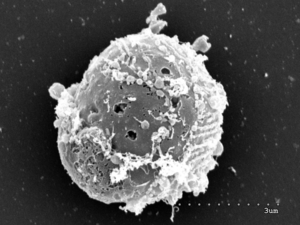코랄로키트리움속
|
| ||
|---|---|---|
 Corallochytrium limacisporum | ||
| 생물 분류ℹ️ | ||
| 역: | 진핵생물 | |
| (미분류): | 단편모생물 | |
| (미분류): | 후편모생물 | |
| (미분류): | 플루리포르메아 | |
| 강: | 코랄로키트리움강 (Corallochytrea) Cavalier-Smith 1995 | |
| 목: | 코랄로키트리움목 (Corallochytrida) Cavalier-Smith 1995 | |
| 과: | 코랄로키트리움과 (Corallochytridae) | |
| 속: | 코랄로키트리움속 (Corallochytrium) | |
| 모식종 | ||
| Corallochytrium limacisporum | ||
| [출처 필요] | ||
| 종 | ||
| ||
코랄로키트리움속(Corallochytrium)은 아라비아해 락샤드위프 제도의 산호초 지대에서 발견되는 단세포 진핵생물 속이다.[1] 후편모생물이지만 다른 생물군과의 근연 관계는 명확하지 않다. 예를 들어 동물 또는 균류 중 어느 쪽과 더 가까운지 확실치 않다.[2]
하위 종
[편집]- Corallochytrium confervae
- Corallochytrium limacisporum
계통 분류
[편집]다음은 후편모생물의 계통 분류이다.[3][4][5][6]
| 후편모생물 |
| ||||||||||||||||||||||||||||||||||||||||||||||||||||||||||||||||||||||||||||||||||||
각주
[편집]- ↑ Raghu-Kumar, S (1987), “Occurrence of the thraustochytrid, Corallochytrium limacisporum gen. et sp. nov. in the coral reef lagoons of the Lakshadweep Islands in the Arabian Sea”, 《Botanica Marina [BOT. MAR.]》 30 (1): 83–89, 2012년 2월 23일에 원본 문서에서 보존된 문서, 2013년 4월 21일에 확인함
- ↑ Sumathi, Jc; Raghukumar, S; Kasbekar, Dp; Raghukumar, C (2006년 Oct월), “Molecular evidence of fungal signatures in the marine protist Corallochytrium limacisporum and its implications in the evolution of animals and fungi.”, 《Protist》 157 (4): 363–76, doi:10.1016/j.protis.2006.05.003, PMID 16899404
- ↑ Peterson, Kevin J.; Cotton, James A.; Gehling, James G.; Pisani, Davide (2008년 4월 27일). “The Ediacaran emergence of bilaterians: congruence between the genetic and the geological fossil records”. 《Philosophical Transactions of the Royal Society of London B: Biological Sciences》 363 (1496): 1435–1443. doi:10.1098/rstb.2007.2233. PMC 2614224. PMID 18192191.
- ↑ Parfrey, Laura Wegener; Lahr, Daniel J. G.; Knoll, Andrew H.; Katz, Laura A. (2011년 8월 16일). “Estimating the timing of early eukaryotic diversification with multigene molecular clocks”. 《Proceedings of the National Academy of Sciences》 108 (33): 13624–13629. doi:10.1073/pnas.1110633108. PMC 3158185. PMID 21810989.
- ↑ Hehenberger, Elisabeth; Tikhonenkov, Denis V.; Kolisko, Martin; Campo, Javier del; Esaulov, Anton S.; Mylnikov, Alexander P.; Keeling, Patrick J. (2017). “Novel Predators Reshape Holozoan Phylogeny and Reveal the Presence of a Two-Component Signaling System in the Ancestor of Animals”. 《Current Biology》 27 (13): 2043–2050.e6. doi:10.1016/j.cub.2017.06.006. PMID 28648822.
- ↑ Tedersoo, Leho; Sanchez-Ramırez, Santiago; Koljalg, Urmas; Bahram, Mohammad; Doring, Markus; Schigel, Dmitry; May, Tom; Ryberg, Martin; Abarenkov, Kessy (2018년 2월 22일). “High-level classification of the Fungi and a tool for evolutionary ecological analyses”. 《Fungal Diversity》 90 (1): 135–159. doi:10.1007/s13225-018-0401-0.
- ↑ 가 나 BCG1 = basal clone group 1, BCG2 = basal clone group 2